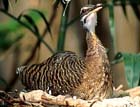England’s landscape and wildlife threatened
A Natural England report claims that global warming will lead to the destruction of our landscape and extinction of many species


In a report on the future of England’s countryside, Natural England warns that many of our treasured landscapes and wildlife will be seriously threatened by global warming. Rare species such as the bittern (pictured) are in danger of dying out as their habitats are altered irrevocably.
The Norfolk Broads will be flooded when sea levels rise, affecting species such as the yellow wagtail, the turtle dove and fish, which all rely on the fresh-water habitat.
The Shropshire Hills will lose species that are unable to adapt to the changes in the climate, which make food available at different times of year, such as the and migratory birds such as the cuckoo and pied wagtail.
The report claims that the Dorset Downs and Cranbourne Chase, both Areas of Oustanding Natural Beauty, will resemble Portugal by 2080. This change in climate will lead to drought, which will affect beech trees, and flooding in winter, which will threaten iconic landmarks such as the Iron Age forts of Maiden Castle.
Dr Helen Philips, chief executive of Natural England, says: ‘Our most precious species, habitats and landscapes urgently need to be managed with climate change in mind.
‘Anticipating how particular areas might be affected and developing targeted local responses will be a value means for us to understand how the natural environment can adapt to the climate challenges it faces.’
The Environment Agency has echoed this sentiment in a separate report on the Thames Barrier, which it claims will need to be modified or replaced by 2070 to deal with rising river levels.
Sign up for the Country Life Newsletter
Exquisite houses, the beauty of Nature, and how to get the most from your life, straight to your inbox.
To comment on this article, use the comment box below, or email us at clonews@ipcmedia.com. Read more about the countryside
Country Life is unlike any other magazine: the only glossy weekly on the newsstand and the only magazine that has been guest-edited by HRH The King not once, but twice. It is a celebration of modern rural life and all its diverse joys and pleasures — that was first published in Queen Victoria's Diamond Jubilee year. Our eclectic mixture of witty and informative content — from the most up-to-date property news and commentary and a coveted glimpse inside some of the UK's best houses and gardens, to gardening, the arts and interior design, written by experts in their field — still cannot be found in print or online, anywhere else.
-
 10 outstanding British gardens from the Country Life Archive
10 outstanding British gardens from the Country Life ArchiveWith Chelsea Flower Show is on the horizon, we've mined the 128-year-old Country Life Archives for 10 inspiring gardens from across our Isles.
-
 A rollercoaster, Bauhaus department store and Brutalist football stand top the latest Buildings at Risk List
A rollercoaster, Bauhaus department store and Brutalist football stand top the latest Buildings at Risk ListThe latest Buildings at Risk List from the Twentieth Century Society has been announced. Sunwin House department store and Blackpool’s Grand National Rollercoaster both feature.